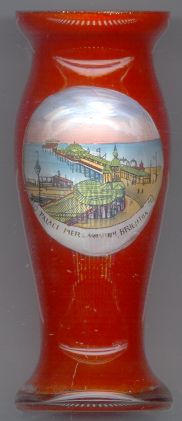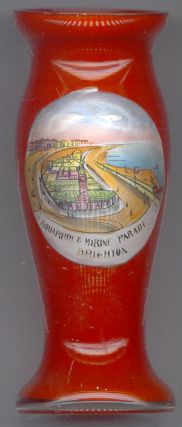

|
| UNITED KINGDOM OF GREAT BRITAIN AND NORTHERN IRELAND |
| England |
| Region: South East England |
| Unitary Authority: Brighton and Hove – Ceremonial County: East Sussex |
Brighton is one of England's most renowned coastal seaside resorts.
The earliest traces of human settlements go back to Neolithic and Bronze Age times.
Although the Romans had lived in this area they left only few traces behind.
The first settlers in what today iy central brighton were the Saxons.
The oldest documented mention of the fishing village of "Bristelmestune" is found in the Doomesday Book of 1086,
the first census of England commissioned by William the Conquerer. Hove was first mentioned in 1288.
In 1313 Brighton received a charter permitting it to hold a weekly market and an annual fair.
After a period of severe decline in the 16th century a new era started when the
healing properties of seawater cures were first proclaimed in 1750. When George Prince of Wales (Prince Regent in 1811, King George IV in 1820),
first visited Brighton in 1783 and decided to stay, the town soon became fashionable with the
aristocracy and the jet set of the time. The "Regency period", roughly between 1800 and 1830,

 saw major developments of both Brighton and Hove including the famous transformation of the Royal Pavilion by John Nash in 1822.
When the London to Brighton railroad opened in 1841 the town began to attract holiday makers on mass.
A rather grim side of Brighton between the wars is described in Graham Greene's famous book "Brighton Rock", published in 1938.
Towards the end of the 20th century Brighton had lost much of its attractivity but due to the opening of the
Brighton Centre in 1977 the town could attract numerous large conferences. At the same time Hove
could retain an identity as a genteel, wealthy town and continued to be popular as a holiday town.
In 1997 Brighton and Hove were officially merged and the municipality of Brighton and Hove became a unitary authority, which
was awarded the status of a city in 2000.
saw major developments of both Brighton and Hove including the famous transformation of the Royal Pavilion by John Nash in 1822.
When the London to Brighton railroad opened in 1841 the town began to attract holiday makers on mass.
A rather grim side of Brighton between the wars is described in Graham Greene's famous book "Brighton Rock", published in 1938.
Towards the end of the 20th century Brighton had lost much of its attractivity but due to the opening of the
Brighton Centre in 1977 the town could attract numerous large conferences. At the same time Hove
could retain an identity as a genteel, wealthy town and continued to be popular as a holiday town.
In 1997 Brighton and Hove were officially merged and the municipality of Brighton and Hove became a unitary authority, which
was awarded the status of a city in 2000.
The  Palace Pier [left] was constructed in 1899 and still is one of Brighton's
most popular tourist attractions.
Palace Pier [left] was constructed in 1899 and still is one of Brighton's
most popular tourist attractions.
The  Aquarium [left, no. 1621: foreground, and right, no. 1623]
opened in 1872 and at that time was acclaimed as being the largest and most imaginative aquarium of the world.
The aquarium was rebuilt on improved and more modern lines in 1925–1929.
Aquarium [left, no. 1621: foreground, and right, no. 1623]
opened in 1872 and at that time was acclaimed as being the largest and most imaginative aquarium of the world.
The aquarium was rebuilt on improved and more modern lines in 1925–1929.
 Volk's Light Railway [left, no. 1621: the small pavilion in the left corner of the picture]
was built by Magnus Vok in 1883 as England's first electric railway. The line was extended in 1901 to more or less it's current route
and connects Brighton Pier and Black Rock (about one and a quarter mile away). The line is still operating using it's original rolling stock,
which makes it the world's oldest still operational electric railway.
Volk's Light Railway [left, no. 1621: the small pavilion in the left corner of the picture]
was built by Magnus Vok in 1883 as England's first electric railway. The line was extended in 1901 to more or less it's current route
and connects Brighton Pier and Black Rock (about one and a quarter mile away). The line is still operating using it's original rolling stock,
which makes it the world's oldest still operational electric railway.
![[scale]](lineal.jpg)